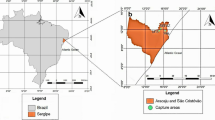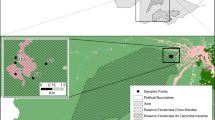Abstract
Bat bugs are often roost ectoparasites of bats. Previous studies have shown that bats shifting roosts within the growing season prevent the massive reproduction of these parasites. We postulated that there could be other antiparasitic strategies of philopatric bats roosting in non-dwelling spacious roosts. Unfortunately, there are no studies devoted to such a topic. For 3 years, two attics highly and less infested by bat bugs (Cimex pipistrelli) with breeding females of Myotis myotis were monitored. From April, after the arrival of the bats, to November, abundance of all instars and adult bugs was sampled in the attics by adhesive traps. We found different patterns in the bug abundances and dynamics in the two attics. In highly infested attic, bat bugs induced pregnant females to move from the infested site of the attic to the non-infested one. Internal temperature and relative humidity were similar in both infested and non-infested sites. Females roosted in the infested site till time before parturition and then moved to the non-infested site within attic. When bats were absent in their old site, the abundance of nymphal instars of bugs decreased by half. Although adult bats can survive under high parasite loads of bat bugs, reproducing females prevent parasite reproduction and simultaneously reduce parasite load in the young by shifting inside spacious roosts.



Similar content being viewed by others
References
Aldana E, Abramson CI, Lizano E, Vegas R, Sulbaran-Romero E (2008) Learning and orientation to odour in the bug Rhodnius prolixus Stal 1859 under laboratory conditions. Parasitol Res 103:587–594
Bartonička T (2008) Cimex pipistrelli (Heteroptera, Cimicidae) and the dispersal propensity of bats: an experimental study. Parasitol Res 104:163–168
Bartonička T, Gaisler J (2007) Seasonal dynamics in the numbers of parasitic bugs (Heteroptera, Cimicidae): a possible cause of roost switching in bats (Chiroptera, Vespertilionidae). Parasitol Res 100:1323–1330
Dubinin VB (1947) Ekologicheskie nabludeniya nad krovososushchimi klopami sem. Cimicidae Daurskoi stepi. Entomol Oboz 29:232–246, In Russian
East ML, Höner OP, Wachter B, Wilhelm K, Burke T, Hofer H (2009) Maternal effects on offspring social status in spotted hyenas. Behav Ecol 20:478–483
Entwistle AC, Racey PA, Speakman JR (2000) Social and population structure of a gleaning bat, Plecotus auritus. J Zool London 225:11–17
Evans LN (2009) Roosting behaviour of urban microbats: the influence of ectoparasites, roost microclimate and sociality. PhD thesis, Faculty of Veterinary Science, University of Melbourne
Giorgi MS, Arlettaz R, Christe P, Vogel P (2001) The energetic grooming costs imposed by a parasitic mite (Spinturnix myoti) upon its bat host (Myotis myotis). Proc R Soc Lond B Biol Sci 268:2071–2075
Harbusch C, Racey PA (2006) The sessile serotine: the influence of roost temperature on philopatry and reproductive phenology of Eptesicus serotinus (Schreber, 1774) (Mammalia: Chiroptera). Acta Chiropterol 8:213–229
Hase A (1917) Die bettwanze (Cimex lectularius L.) ihr leben und ihre bekämpfung. Monogr Angew Entomol 1 (Z Angew Entomol 4, Beiheft I)
Hase A (1930) Weitere versuche zur kenntnis der bettwanzen Cimex lectularius L. und Cimex rotundatus Sign. (Hem. Rhinch.). Parasitol Res 2:368–418
Henshaw RE (1960) Responses of free-tailed bats to increase in cave temperature. J Mammal 41:396–398
Johnson CG (1960) The relation of weight of food ingested to increase in body-weight during growth in the bed-bug, Cimex lectularius L. (Hemiptera). Ent Exp Appl 3:238–240
Jones RM (1930) Some effects of temperature and humidity as factors in the biology of the bedbug (Cimex lectularius Linn.). Ann Entomol Soc Am 23:105–119
Kemper H (1936) Die bettwanze und ihre bekämpfung. Zeitt Kleintierk Pelztierk 12:1–107
Kerth G, Weissmann K, König B (2001) Day roost selection in female Bechstein's bats (Myotis bechsteinii): a field experiment to determine the influence of roost temperature. Oecologia 126:1–9
Kolb A (1950) Beiträge zur Biologie einheimischer Fledermäuse. Zool Jb (Syst) 78:547–572
Kunz TH, Fenton MB (2003) Bat ecology. University of Chicago, Chicago
Licht P, Leitner P (1967) Behavioral responses to high temperatures in three species of california bats. J Mammal 48:52–61
Lourenço SI, Palmeirim JM (2004) Influence of temperature in roost selection by Pipistrellus pygmaeus (Chiroptera): relevance for the design of bat boxes. Biol Conserv 119:137–285
Lourenço SI, Palmeirim JM (2008) Which factors regulate the reproduction of ectoparasites of temperate-zone cave-dwelling bats? Parasitol Res 104:127–134
Lučan RK (2006) Relationships between the parasitic mite Spinturnix andegavinus (Acari: Spinturnicidae) and its bat host, Myotis daubentonii (Chiroptera: Vespertilionidae): seasonal, sex- and age-related variation in infestation and possible impact of the parasite on the host condition and roosting behaviour. Folia Parasitol 53:147–152
Marx R (1955) Ueber die Wirtsfindung und die Bedeutung des arts-spezifischen duftstoffes bei Cimex lectularius Linné. Parasitol Res 17:41–72
Mislin H (1942) Zur biologie der Chiroptera. I. Beobachtungen im sommerquartier der Myotis myotis Borkh. Rev Suisse Zool 49:200–206
Petri B, Pääbo S, von Haeseler A, Tautz D (1997) Paternity assessment and population subdivision in a natural population of the larger mouse-eared bat Myotis myotis. Mol Ecol 6:235–242
Reckardt K, Kerth G (2007) Roost selection and roost switching of female Bechstein’s bats (Myotis bechsteinii) as a strategy of parasite avoidance. Oecologia 154:581–588
Reinhardt K, Siva-Jothy MT (2007) Biology of the bed bugs (Cimicidae). Annu Rev Entomol 52:351–374
Rivnay E (1932) Studies in tropisms of the bed bug Cimex lectularius L. Parasitology 24:121–136
Schneider M, Hammer M (2006) Monitoring the greater mouse-eared bat Myotis myotis on a landscape scale. In: Hurford C, Schneider M (eds) Monitoring nature conservation in cultural habitats. Springer, the Netherlands, pp 231–146
Southwood TRE (1954) The production of fertile eggs by Cimex pipistrelli Jenyns (Hem., Cimicidae) when fed on human blood. Entomol Monthly Mag 40:35
Stutt A, Siva-Jothy M (2001) Traumatic insemination and sexual conflict in the bed bug Cimex lectularius. Proc Natl Acad Sci USA 98:5683–5687
Usinger RL (1966) Monograph of Cimicidae (Hemiptera—Heteroptera). Entomological Society of America, College Park
Walter G (1996) Zum ektoparasitenbefall der fledermäuse und den potentiellen auswirkungen. Myotis 34:85–92
Whitaker JO Jr (1998) Life history and roost switching in six summer colonies of eastern Pipistrelles in buildings. J Mammal 79:651–659
Willis CKR, Brigham MM (2004) Roost switching, roost sharing and social cohesion: forest-dwelling big brown bats, Eptesicus fuscus, conform to the fission–fusion model. Anim Behav 68:495–505
Willis CKR, Kolar KA, Karst AL, Kalcounis-Rueppell MC, Brigham RM (2003) Medium- and long-term reuse of trembling aspen cavities by big brown bats (Eptesicus fuscus). Acta Chiropterol 5:85–90
Zahn A, Rupp D (2004) Ectoparasite load in European vespertilionid bats. J Zool 262:383–391
Acknowledgments
We are very grateful to J. Gaisler for valuable comments on the manuscript and G. Filby for correction of English. The study was supported by grant no. 206/07/P098 of the Science Foundation of the Czech Republic and the Czech Bat Conservation Trust, and by grants from the Ministry of Environment and the Ministry of Education, Youth and Sports of the Czech Republic no. MSM0021622416.
Author information
Authors and Affiliations
Corresponding author
Rights and permissions
About this article
Cite this article
Bartonička, T., Růžičková, L. Bat bugs (Cimex pipistrelli) and their impact on non-dwelling bats. Parasitol Res 111, 1233–1238 (2012). https://doi.org/10.1007/s00436-012-2957-z
Received:
Accepted:
Published:
Issue Date:
DOI: https://doi.org/10.1007/s00436-012-2957-z




